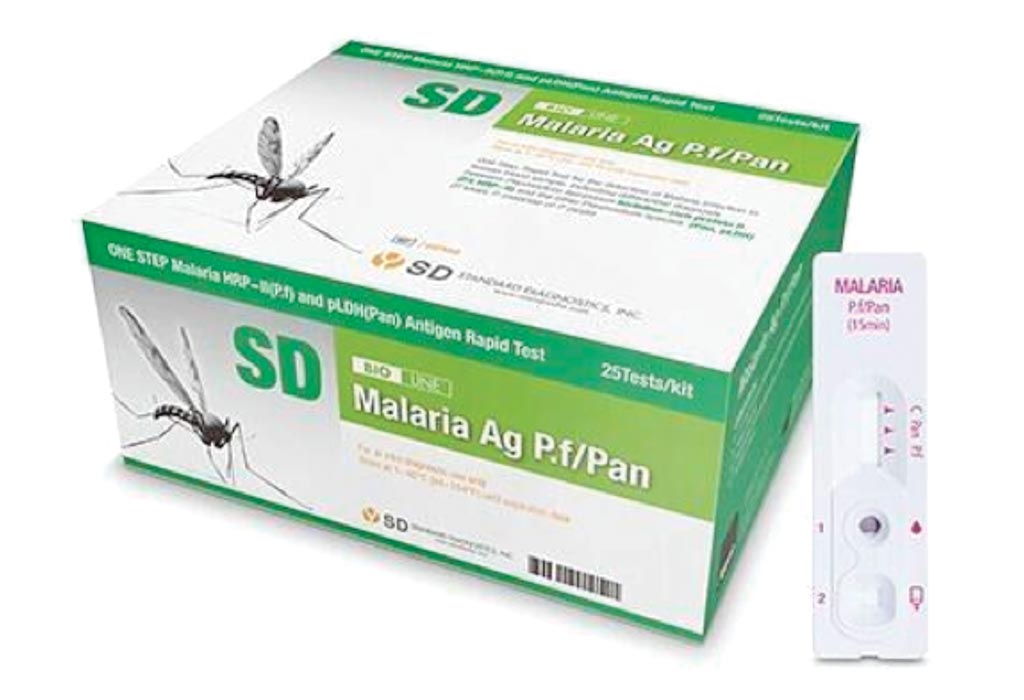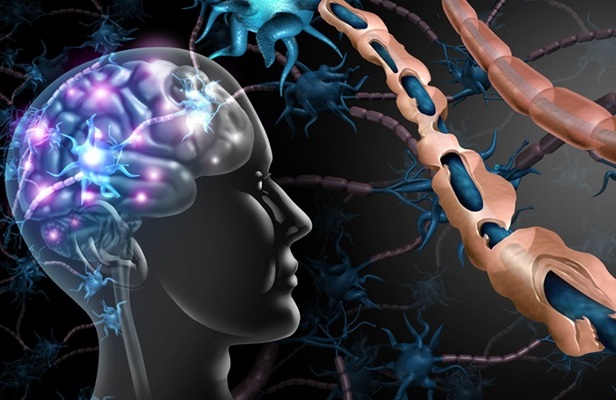Rapid Malaria Diagnostic Test Detects Placental Infection
|
By LabMedica International staff writers Posted on 19 Dec 2018 |

Image: The SD BIOLINE Malaria Ag P.f/Pan test is a rapid, qualitative and differential test for the detection of histidine-rich protein II (HRP-II) antigen of Plasmodium falciparum and common Plasmodium lactate dehydrogenase (pLDH) of Plasmodium species in human whole blood (Photo courtesy of Alere).
Malaria remains one of the most important parasitic infections in humans. It is endemic throughout the tropical and subtropical regions of the world and is responsible for more than 200 million clinical cases and more than 400,000 deaths each year.
Plasmodium falciparum infected erythrocytes sequestering in placental tissue release Plasmodium lactate dehydrogenase (pLDH) and histidine-rich protein-II (HRP-II). These proteins can be detected in peripheral blood using monoclonal antibody-based rapid diagnostic tests (RDTs).
Scientists affiliated with the University of Yaoundé 1 prepared Giemsa-stained blood smears for peripheral blood smear (Pbs), placental intervillous space (IVS) blood smear and placental tissue impression smear (PTIS) from HIV-negative women during delivery. If parasites were not detected after examining 200 microscopic fields of thick smears, the sample was considered malaria negative; however, when parasites were detected, parasitaemia was estimated per microliter of blood. Both thin film and impression smear were used to determine parasite species.
Hemoglobin (Hb) levels in maternal blood were determined using the URIT-3300, Coulter Counter and a woman was diagnosed as anemic if her Hb was less than 11 g/dL. The One Step HRP-II and pLDH RDT SD Bioline malaria antigen P.f/pan was used to diagnose malaria infection in the peripheral blood samples.
The scientists reported that the prevalence of malaria was 16%, 7.5%, 11.5%, 8% and 13% for One Step malaria HRP-II and pLDH RDTs, peripheral blood smear, IVS blood and placental tissue impression smears, respectively. The proportion of women positive by One Step malaria pLDH RDT and Pbs increased with parasite density in PTIS, while One Step malaria HRP-II RDT detected high proportion of infected women even with low parasite density. The sensitivity of One Step malaria HRP-II and pLDH RDTs were 96.15% and 61.53%, respectively, compared to 80.76% for Pbs. The specificity of these RDTs was 96.49% and 100%, respectively, compared to 100% for Pbs.
The authors concluded that their results depict One Step malaria HRP-II RDT to be better in detecting placental P. falciparum infection in pregnant women compared to Giemsa-stained peripheral thick blood smear. This is important for better case management since microscopic examination of PTIS cannot be employed during pregnancy. The study was published on December 4, 2018, in the Malaria Journal.
Related Links:
University of Yaoundé 1
Plasmodium falciparum infected erythrocytes sequestering in placental tissue release Plasmodium lactate dehydrogenase (pLDH) and histidine-rich protein-II (HRP-II). These proteins can be detected in peripheral blood using monoclonal antibody-based rapid diagnostic tests (RDTs).
Scientists affiliated with the University of Yaoundé 1 prepared Giemsa-stained blood smears for peripheral blood smear (Pbs), placental intervillous space (IVS) blood smear and placental tissue impression smear (PTIS) from HIV-negative women during delivery. If parasites were not detected after examining 200 microscopic fields of thick smears, the sample was considered malaria negative; however, when parasites were detected, parasitaemia was estimated per microliter of blood. Both thin film and impression smear were used to determine parasite species.
Hemoglobin (Hb) levels in maternal blood were determined using the URIT-3300, Coulter Counter and a woman was diagnosed as anemic if her Hb was less than 11 g/dL. The One Step HRP-II and pLDH RDT SD Bioline malaria antigen P.f/pan was used to diagnose malaria infection in the peripheral blood samples.
The scientists reported that the prevalence of malaria was 16%, 7.5%, 11.5%, 8% and 13% for One Step malaria HRP-II and pLDH RDTs, peripheral blood smear, IVS blood and placental tissue impression smears, respectively. The proportion of women positive by One Step malaria pLDH RDT and Pbs increased with parasite density in PTIS, while One Step malaria HRP-II RDT detected high proportion of infected women even with low parasite density. The sensitivity of One Step malaria HRP-II and pLDH RDTs were 96.15% and 61.53%, respectively, compared to 80.76% for Pbs. The specificity of these RDTs was 96.49% and 100%, respectively, compared to 100% for Pbs.
The authors concluded that their results depict One Step malaria HRP-II RDT to be better in detecting placental P. falciparum infection in pregnant women compared to Giemsa-stained peripheral thick blood smear. This is important for better case management since microscopic examination of PTIS cannot be employed during pregnancy. The study was published on December 4, 2018, in the Malaria Journal.
Related Links:
University of Yaoundé 1
Latest Microbiology News
- New UTI Diagnosis Method Delivers Antibiotic Resistance Results 24 Hours Earlier
- Breakthroughs in Microbial Analysis to Enhance Disease Prediction
- Blood-Based Diagnostic Method Could Identify Pediatric LRTIs
- Rapid Diagnostic Test Matches Gold Standard for Sepsis Detection
- Rapid POC Tuberculosis Test Provides Results Within 15 Minutes
- Rapid Assay Identifies Bloodstream Infection Pathogens Directly from Patient Samples
- Blood-Based Molecular Signatures to Enable Rapid EPTB Diagnosis
- 15-Minute Blood Test Diagnoses Life-Threatening Infections in Children
- High-Throughput Enteric Panels Detect Multiple GI Bacterial Infections from Single Stool Swab Sample
- Fast Noninvasive Bedside Test Uses Sugar Fingerprint to Detect Fungal Infections
- Rapid Sepsis Diagnostic Device to Enable Personalized Critical Care for ICU Patients
- Microfluidic Platform Assesses Neutrophil Function in Sepsis Patients
- New Diagnostic Method Confirms Sepsis Infections Earlier
- New Markers Could Predict Risk of Severe Chlamydia Infection
- Portable Spectroscopy Rapidly and Noninvasively Detects Bacterial Species in Vaginal Fluid
- CRISPR-Based Saliva Test Detects Tuberculosis Directly from Sputum
Channels
Clinical Chemistry
view channel
Blood Test Could Predict and Identify Early Relapses in Myeloma Patients
Multiple myeloma is an incurable cancer of the bone marrow, and while many patients now live for more than a decade after diagnosis, a significant proportion relapse much earlier with poor outcomes.... Read more
Compact Raman Imaging System Detects Subtle Tumor Signals
Accurate cancer diagnosis often depends on labor-intensive tissue staining and expert pathological review, which can delay results and limit access to rapid screening. These conventional methods also make... Read moreMolecular Diagnostics
view channel
Blood Test Combined with MRI Brain Scans Reveals Two Distinct Multiple Sclerosis Types
Multiple sclerosis (MS) affects more than 2.8 million people worldwide, yet predicting how the disease will progress in individual patients remains difficult. Current MS classifications are based on clinical... Read more
Ultra-Sensitive Blood Biomarkers Enable Population-Scale Insights into Alzheimer’s Pathology
Accurately estimating how many people carry Alzheimer’s disease pathology has long been a challenge, as traditional methods rely on small, clinic-based samples rather than the general population.... Read more
Blood Test Could Predict Death Risk in World’s Most Common Inherited Heart Disease
Hypertrophic cardiomyopathy (HCM) is the world’s most common inherited heart condition and affects millions of people globally. While some patients live with few or no symptoms, others develop heart failure,... Read moreHematology
view channel
MRD Tests Could Predict Survival in Leukemia Patients
Acute myeloid leukemia is an aggressive blood cancer that disrupts normal blood cell production and often relapses even after intensive treatment. Clinicians currently lack early, reliable markers to predict... Read more
Platelet Activity Blood Test in Middle Age Could Identify Early Alzheimer’s Risk
Early detection of Alzheimer’s disease remains one of the biggest unmet needs in neurology, particularly because the biological changes underlying the disorder begin decades before memory symptoms appear.... Read more
Microvesicles Measurement Could Detect Vascular Injury in Sickle Cell Disease Patients
Assessing disease severity in sickle cell disease (SCD) remains challenging, especially when trying to predict hemolysis, vascular injury, and risk of complications such as vaso-occlusive crises.... Read more
ADLM’s New Coagulation Testing Guidance to Improve Care for Patients on Blood Thinners
Direct oral anticoagulants (DOACs) are one of the most common types of blood thinners. Patients take them to prevent a host of complications that could arise from blood clotting, including stroke, deep... Read moreImmunology
view channel
Ultrasensitive Liquid Biopsy Demonstrates Efficacy in Predicting Immunotherapy Response
Immunotherapy has transformed cancer treatment, but only a small proportion of patients experience lasting benefit, with response rates often remaining between 10% and 20%. Clinicians currently lack reliable... Read more
Blood Test Could Identify Colon Cancer Patients to Benefit from NSAIDs
Colon cancer remains a major cause of cancer-related illness, with many patients facing relapse even after surgery and chemotherapy. Up to 40% of people with stage III disease experience recurrence, highlighting... Read morePathology
view channel
Genetics and AI Improve Diagnosis of Aortic Stenosis
Aortic stenosis is a progressive narrowing of the aortic valve that restricts blood flow from the heart and can be fatal if left untreated. There are currently no medical therapies that can prevent or... Read more
AI Tool Simultaneously Identifies Genetic Mutations and Disease Type
Interpreting genetic test results remains a major challenge in modern medicine, particularly for rare and complex diseases. While existing tools can indicate whether a genetic mutation is harmful, they... Read more
Rapid Low-Cost Tests Can Prevent Child Deaths from Contaminated Medicinal Syrups
Medicinal syrups contaminated with toxic chemicals have caused the deaths of hundreds of children worldwide, exposing a critical gap in how these products are tested before reaching patients.... Read more
Tumor Signals in Saliva and Blood Enable Non-Invasive Monitoring of Head and Neck Cancer
Head and neck cancers are among the most aggressive malignancies worldwide, with nearly 900,000 new cases diagnosed each year. Monitoring these cancers for recurrence or relapse typically relies on tissue... Read moreTechnology
view channel
Pioneering Blood Test Detects Lung Cancer Using Infrared Imaging
Detecting cancer early and tracking how it responds to treatment remains a major challenge, particularly when cancer cells are present in extremely low numbers in the bloodstream. Circulating tumor cells... Read more
AI Predicts Colorectal Cancer Survival Using Clinical and Molecular Features
Colorectal cancer is one of the most common and deadly cancers worldwide, and accurately predicting patient survival remains a major clinical challenge. Traditional prognostic tools often rely on either... Read moreIndustry
view channel
BD and Penn Institute Collaborate to Advance Immunotherapy through Flow Cytometry
BD (Becton, Dickinson and Company, Franklin Lakes, NJ, USA) has entered into a strategic collaboration with the Institute for Immunology and Immune Health (I3H, Philadelphia, PA, USA) at the University... Read more




 assay.jpg)













